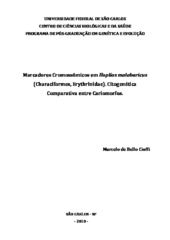Marcadores cromossômicos em Hoplias malabaricus (Characiformes, Erythrinidae). Citogenética comparativa entre cariomorfos
Abstract
Hoplias malabaricus, a widespread Erythrinidae fish, is characterized by a karyotypic diversity, with seven karyomorphs already described. This report presented a comparative study of the karyomorphs A, B, C and D, which were previously included in a major karyotypic group (Group I), in order to evaluate the evolutionary relationships among them. The in situ investigation of several classes of repetitive DNAs added new informative characters useful in comparative genomics and provided new insights into the evolutionary relationships among karyomorphs. In addition to corroborate the inclusion of karyomorphs A-D in a close evolutionary group, the results provide further evidence for a greater proximity between the karyomorphs A-B and karyomorphs C-D. A comparative analysis among distinct populations of karyomorph A demonstrated a continuing genomic differentiation in this group, allowing the detection of recent evolutionary events, suggesting that this karyomorph cannot be considered an absolute evolutionary unit, as evidenced by their inner chromosomal differentiation. It was also expanded our knowledge of the sex chromosomes differentiation in H. malabaricus, allowing to conclude that repetitive DNAs played an important role in the differentiation process. It was detected a cryptic differentiated XX/XY sex chromosome system in karyomorph C, which is clearly correlated with the evolution of the X1X1X2X2/X1X2Y sex chromosome system of karyomorph D. The cytogenetic mapping of five classes of repetitive DNAs also indicated the probable derivation of the XX/XY chromosomes of karyomorph B from autosomal chromosomes of karyomorph A. In this case, the X chromosomes were seen as the preferred site for the accumulation of DNA repeats, which represents an unusual condition of X accumulating more repetitive DNAs than Y chromosome in fish. The overall results were able to demonstrate that the repetitive DNA fraction of the genome constitutes good evolutionary markers in H. malabaricus, allowing to improve the understanding of the evolutionary mechanisms that have generated the complex genomic structure found in this fish group.
